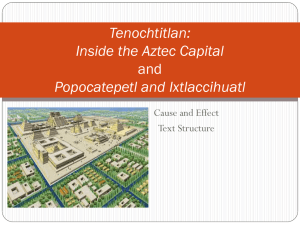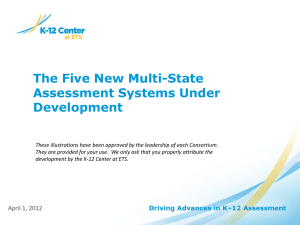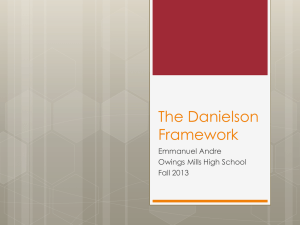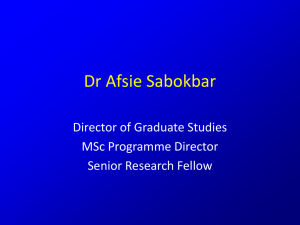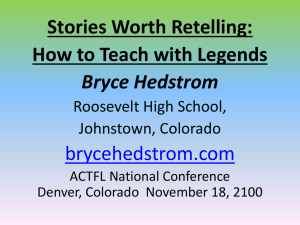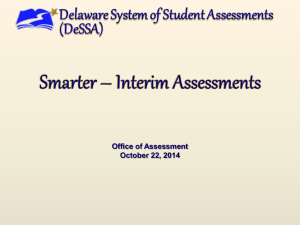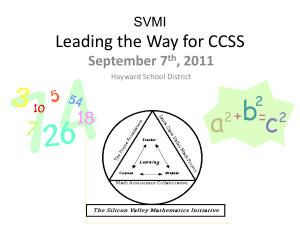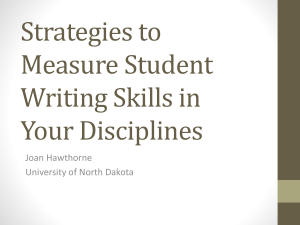LEGENDS and SB290 - Salem
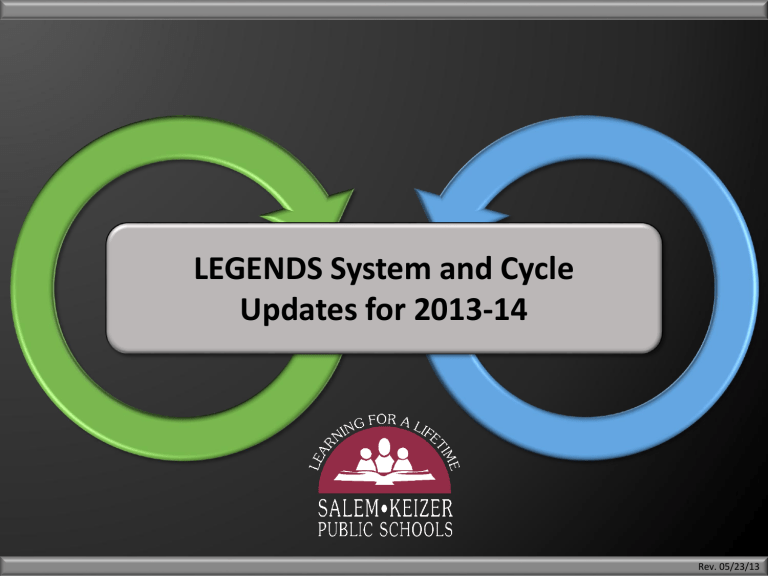
LEGENDS System and Cycle
Updates for 2013-14
Rev. 05/23/13
A Note About This Presentation:
Please hold any questions until the end of PowerPoint, as questions raised early in the presentation may be addressed within later slides.
Thank you!
Setting the Stage
LEGENDS Today
The Current LEGENDS Evaluation Cycle – Key Elements
LEGENDS Rubric
Multiple Observations
Goal Setting
Initial Professional Growth
Conference
Summative Professional
Growth Conference
Observations
Observations
Interim Professional
Growth Conference
Robust Evaluation Cycle
The “Why” Behind Change
User Feedback and State Legislation
The “Why” Behind Change – Your Feedback
Over 1,100 licensed staff and administrators participated in the 2012-13 LEGENDS survey.
Key Feedback Points:
• The general LEGENDS rubric does not fit all positions
• Staff appreciate multiple observations, but worry about the time and work involved
• Completing the rubric during each conference isn’t always helpful
• Rubric language is sometimes unclear or confusing
The “Why” Behind Change –
Senate Bill 290 and the Oregon Framework
Senate Bill 290 proposed significant changes to the way educators and administrators are evaluated in the State of Oregon.
Based upon the bill, a statewide committee of practitioners created the Oregon
Educator Effectiveness Framework.
The “Why” Behind Change –
Key Elements of Oregon Framework
(1)
Standards of
Professional
Practice
(2)
Differentiated
Performance
Levels
(3)
Multiple
Measures
(4)
Evaluation
And
Professional
Growth
Cycle
(5)
Aligned
Professional
Development
The Current LEGENDS Evaluation Cycle –
Key Elements of Oregon Framework Match LEGENDS Key Elements
(1)
Standards of
Professional
Practice
(2)
Differentiated
Performance
Levels
(5)
Aligned
Professional
Development
LEGENDS Rubric
(4)
Evaluation
And
Professional
Growth
Cycle
Multiple Observations
(3)
Multiple
Measures
Goal Setting
Initial Professional Growth
Conference
Summative Professional
Growth Conference
(4)
Evaluation
Observations
Observations
And
Professional
Growth
Cycle Interim Professional
Growth Conference
Robust Evaluation Cycle
Key Elements of the Oregon Framework –
What are Multiple Measures?
The Oregon Educator Effectiveness Framework requires the implementation of
Multiple Measures of effectiveness in both the educator and administrator evaluation processes.
The below graphic illustrates the three measure categories for Salem-Keizer licensed staff.
Evidence of Professional Practice
Measured By: LEGENDS Standards 1-8
Evidence of Professional Responsibilities
Measured By: LEGENDS Standards 9-10
(3)
Multiple
Measures
Evidence of Student Learning & Growth
Measured By: Student Learning Goals
(SLGs)
Changes for 2013-14
The LEGENDS Cycle
LEGENDS Cycle for Probationary Staff
•
•
Summative Conference
Summative
Evaluation
Goal Results
•
•
•
Interim Conference
Status of Goals
Observations
Reviewed
(If New) Admin
Assessment
Minimum of
6 Observations •
•
Initial Conference
Self-Assessment
Admin Assessment
What’s the Same
• Evaluated annually
• Minimum of 6 observations
(no maximum)
• At least 2 observations have face-to-face feedback
• Observations can be classroom practice, PLCs, meetings, and other areas
• Earlier due date – cycle completed by mid-February
•
•
Goal Setting
2 Student Learning
Goals (SLGs)
1 Professional
Growth Goal (PGG)
Please Note: Cycle also applicable for full-year temporary staff, staff on Supervisor-Directed
Goals, and staff on a Program of Assistance for Improvement
LEGENDS Cycle for Probationary Staff
•
•
•
Interim Conference
Status of Goals
Observations
Reviewed
(If New) Admin
Assessment
•
•
Summative Conference
Summative
Evaluation
Goal Results
Minimum of
6 Observations •
•
Initial Conference
Self-Assessment
Admin Assessment
What’s Different
• 2 Student Learning Goals
(SLGs) and 1 Professional
Growth Goal
• Focus of Interim Conference on status of goals and observation review
• Rubric only used in Interim
Conference if supervisor is new to employee
• Face-to-face observation feedback does not necessarily require a “sitdown” formal meeting
•
•
Goal Setting
2 Student Learning
Goals (SLGs)
1 Professional
Growth Goal (PGG)
Please Note: Cycle also applicable for full-year temporary staff, staff on Supervisor-Directed
Goals, and staff on a Program of Assistance for Improvement
LEGENDS 2-Year Cycle for Contract Staff – “A” Year
•
•
Summative Conference
Summative
Evaluation
Goal Results
•
•
•
Interim Conference
Status of Goals
Observations
Reviewed
(If New) Admin
Assessment
“A” Year
Minimum of
6 Observations
•
•
Initial Conference
Self-Assessment
Review Admin
Assessment
•
•
Goal Setting
2 Student Learning
Goals (SLGs)
1 Professional
Growth Goal (PGG)
What’s the Same
• Has summative evaluation
• Minimum of 6 observations
(no maximum)
• At least 2 observations have face-to-face feedback
• Observations can be classroom practice, PLCs, meetings, and other areas
• Traditional due date – cycle completed by mid-May
• Very similar to Probationary evaluation cycle
•
•
•
Interim Conference
Status of Goals
Observations
Reviewed
(If New) Admin
Assessment
LEGENDS 2-Year Cycle for Contract Staff – “A” Year
•
•
Summative Conference
Summative
Evaluation
Goal Results
“A” Year
Minimum of
6 Observations
•
•
Goal Setting
2 Student Learning
Goals (SLGs)
1 Professional
Growth Goal (PGG)
•
•
Initial Conference
Self-Assessment
Review Admin
Assessment
What’s Different
• 2 Student Learning Goals
(SLGs) and 1 Professional
Growth Goal
• Focus of Interim Conference on status of goals and observation review
• Rubric only used in Interim
Conference if supervisor is new to employee
• Face-to-face observation feedback does not necessarily require a “sitdown” formal meeting
• During an employee’s first time on an “A” year, administrator will complete an Initial Administrator
Assessment. Future “A” years will review the “B” cycle’s end-of-year Administrator
Assessment during the Initial
Conference.
LEGENDS 2-Year Cycle for Contract Staff – “B” Year
•
•
•
Summative Conference
Goal Results
Observations
Reviewed
Admin Assessment
•
•
Initial Conference
Self-Assessment
Review Summative
“B” Year
Minimum of
3 Observations
•
•
Interim Conference
Status of Goals
Observations
Reviewed
What’s the Same
• Observations can be classroom practice, PLCs, meetings, and other areas
• Traditional due date – cycle completed by mid-May
•
•
Goal Setting
2 Student Learning
Goals (SLGs)
1 Professional
Growth Goal (PGG)
LEGENDS 2-Year Cycle for Contract Staff – “B” Year
•
•
•
Summative Conference
Goal Results
Observations
Reviewed
Admin Assessment
•
•
Initial Conference
Self-Assessment
Review Summative
“B” Year
Minimum of
3 Observations
•
•
Interim Conference
Status of Goals
Observations
Reviewed
•
•
Goal Setting
2 Student Learning
Goals (SLGs)
1 Professional
Growth Goal (PGG)
What’s Different
• No Initial Administrator
Assessment; instead, review prior year’s summative evaluation
• 2 Student Learning Goals
(SLGs) and 1 Professional
Growth Goal
• Minimum of 3 observations
(no maximum)
• 1 observation requires faceto-face feedback
• Focus of Interim Conference on status of goals and review of observations
• No summative evaluation; instead, supervisor completes
Interim Administrator
Assessment
•
•
Summative Conference
Summative
Evaluation
Goal Results
•
•
•
Summative Conference
Goal Results
Observations
Reviewed
Admin Assessment
•
•
•
Interim Conference
Status of Goals
Observations
Reviewed
(If New) Admin
Assessment
“A” Year
Minimum of
6 Observations
•
•
Initial Conference
Self-Assessment
Review Admin
Assessment
•
•
Initial Conference
Self-Assessment
Review Summative
“B” Year
Minimum of
3 Observations
•
•
Interim Conference
Status of Goals
Observations
Reviewed
•
•
Goal Setting
2 Student Learning
Goals (SLGs)
1 Professional
Growth Goal (PGG)
•
•
Goal Setting
2 Student Learning
Goals (SLGs)
1 Professional
Growth Goal (PGG)
Combined 2-Year Contract Evaluation Cycle
• Continuous 2-year cycle of evaluation (e.g., “A” to “B” to “A”)
• Due to TIF requirements, all contract TIF staff will be on “A” year
• To ensure roughly equal cycle distribution, District will assign “A” or “B” cycle for all non-TIF contract staff
Changes for 2013-14
LEGENDS Rubrics
LEGENDS Rubrics for 2013-14 – General Licensed Rubric Changes
Based upon your suggestions, the General Licensed
Rubric has been updated for 2013-14.
Changes include:
• Refinements to indicator descriptions and proficiency levels to enhance clarity
• Updated guiding questions and evidence examples to support staff and administrators in recognizing evidence of proficiency both in and out of the classroom
LEGENDS Rubrics for 2013-14 – Specialty Rubrics
In addition to the General Licensed Rubric, many specialty groups will see changes in 2013-14.
Changes include:
• Refinements to guiding questions and evidence for Music, Physical
Education, Special Education, and Counselors
• New, job-specific rubrics for:
• Speech Language Pathologists
• Instructional Coaches and English Language Acquisition Specialists
• Mentors
• Nurses
• Behavior Specialists
• Program Assistants (both Curriculum and Special Education
• Social Workers
• Occupational Therapists and Physical Therapists
• All changes were made by practitioners in each specialty field
Changes for 2013-14
Student Learning Goals (SLGs)
Student Learning Goals (SLGs) – Impact of Oregon Framework
The Oregon Educator Effectiveness
Framework mandates several changes to the goal-setting process for licensed and administrative staff.
Required in 2013-14
1 Professional Growth Goal
• Employee-directed
• Informed by prior observations, evaluations, and self-assessment
• Outlines a plan for professional growth and development
• We currently do these!
2 Student Learning Goals (SLGs)
• Employee-directed
• Data-driven, using Measures of
Student Learning and Growth
• Specific requirements on sources of data
• The name is new, but…
Student Learning Goals (SLGs) – What is an SLG?
Student Learning Goals (SLGs) can seem daunting or confusing…
…but are really just statements of desired student growth, written like the SMART goals we already use!
Student Learning Goals (SLGs) – The SMART Goal Format
Student Learning Goals (SLGs) –
What are Measures of Student Learning and Growth?
Student Learning Goals (SLGs) have specific requirements regarding sources of data.
The official description from ODE:
Student Learning Goals (SLGs) –
What are Measures of Student Learning and Growth?
The most important take-away, however, is much easier:
Are you in an OAKS
Reading or Math tested grade or subject?
(ODE defined as ELA and mathematics in grades 3-8 and 11)
YES NO
1 Goal MUST use OAKS or ELPA
• You determine which students (full class or sub-population)
• You determine how success is measured (e.g., % of students scores increase by specific %)
1 Goal will use another data source
• Many data source options to choose from
2 Goals will use employee-selected data sources
• You determine which students (full class or sub-population)
• You determine how success is measured (e.g., % of students scores increase by specific %)
• Many data source options to choose from
Student Learning Goals (SLGs) –
Who Completes SLGs?
• SLGs are submitted by each staff member, but may be developed collaboratively (e.g., as a school, in PLCs, in jobalike groups).
• Many specialist staff members may have roles which make it challenging to create a goal based explicitly on student growth and achievement
• ODE will soon be releasing information outlining which roles require Student Learning Goals (SLGs), and which do not.
• Staff not required to complete SLGs will still complete datadriven goals in 2013-14, but will have additional flexibility in choosing role-appropriate data sources.
Student Learning Goals (SLGs) –
What Will an SLG Look Like?
Student Learning Goals (SLGs) will be completed in TalentED
Perform, and only consist of two questions.
1.
A SMART Goal Statement
2.
Identifying the Data Source Which Will be Used to Measure the Goal
Student Learning Goals (SLGs) –
What Will an SLG Look Like?
Interim Conferences and SLGs
Prior to the Interim Conference, staff members will reflect upon their Student Learning
Goals (SLGs), and will share via TalentED Perform:
• What progress has been made toward meeting or exceeding the goal?
• What adjustments to strategies or practices need to be made to meet the goal?
Summative Conferences and SLGs
Prior to the Summative Conference, staff members will reflect upon their Student
Learning Goals (SLGs), and will share via TalentED Perform:
• What does the end-of-year data show regarding my goal?
• What worked? What strategies or practices should be revised?
Changes for 2013-14
Student Learning Goal (SLG) Examples
LEGENDS Rubrics for 2013-14 – SLG Examples and Stems
• To better assist staff in preparing SLGs for 2013-14,
Salem-Keizer will provide a number of examples and goal stems to facilitate the goal-writing process.
• Goal stems will function much like a “fill in the blank” or “Mad-lib”, allowing staff members the option to insert their classroom or student-specific data targets into an existing goal.
• While stems and examples will be available, you will still be welcome to create your own, unique goals.
Goals will need to meet ODE and SMART guidelines and requirements.
LEGENDS Rubrics for 2013-14 – SLG Example #1
A Sample SLG Statement Using OAKS
For the 2013-14 school year, 60% of my 3
rd
grade students will meet benchmark (211)
RIT scores as measured by their OAKS 3
rd
Grade Reading assessment.
LEGENDS Rubrics for 2013-14 – SLG Example #2
A Sample SLG Statement Using DRA
For the 2013-14 school year, 29 of my 33 students will show at least 1 year’s worth of growth as measured by the DRA.
LEGENDS Rubrics for 2013-14 – SLG Example #3
A Sample SLG Statement Using Presidential Fitness Test
For the 2013-14 school year, 100% of my 6
th
grade students will improve on the
Presidential Fitness subtests (curl-ups, shuttle run, endurance run/walk, pull-ups, Vsit reach) by an overall average of 20%.
LEGENDS Rubrics for 2013-14 – SLG Example #4
A Sample SLG Statement Using Classroom-Developed Measure
By the end of semester one, 80% of my
American Government students will meet their target post-assessment score, as determined by their pre-assessment results and the target score table below.
Baseline Score Range from Pre-Assessment
20-30
31-50
51-70
71-85
86-100
Target Score on Post-Assessment
70
80
90
90 +
95 +
Interested in Additional Information?
The Oregon Educator Effectiveness Framework is available on
ODE’s website at http://www.ode.state.or.us/wma/teachlearn/educatoreffectiveness/oregon-framework--foreval-and-support-systems.pdf
Rev. 05/20/13
Additional examples, training, and support will be available in
August 2013.
Thank you for your time today!
Rev. 05/20/13
